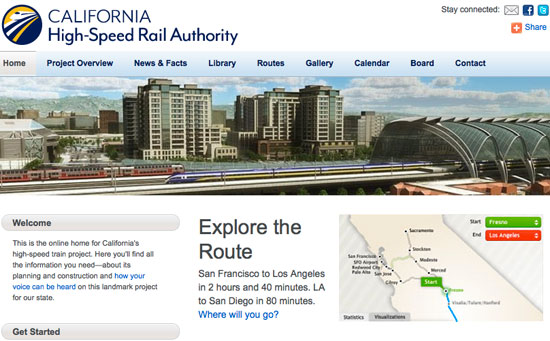
As California's high speed rail project continues to gain attention, both positive and negative, the makeup of visitors to the official website has been shifting, with an increasing number of general public who know very little about the project, according to the California High Speed Rail Authority (CAHSRA). In response to this trend and based on thousands of user surveys and feedback from 13 focus groups, the CAHSRA redesigned its website as a portal it hopes will be more user friendly, intuitive and useful to a wide range of interested public.
"A user-friendly Web site is a key way to reach millions of people both in California and around the world," said Curt Pringle, Chairman of the California High-Speed Rail Authority Board, in a statement. "We took our cues from the people in the online community and revamped our Web site so that it not only provides current and in-depth information, but does it in an easily accessible way."
In addition to creating a cleaner aesthetic and updated navigation bar, CAHSRA indexed and tagged its documents so the search function is more effective, which CAHSRA spokesperson Rachel Wall admitted was a big improvement over the previous iteration. "The previous site wasn't serving people's needs statewide. It had a ton information but it wasn't navigable," said Wall.
In a teleconference with media, Wall demonstrated the site's new functionality, including the new search options that can be geographically narrowed with a simple click for localized data. Wall said this better functionality and tools like the new glossary of terms would enable "every Californian [to] get in touch with the project and understand what's happening."
According to the CAHSRA, current website traffic is about 40,000 monthly visitors, depending on the visibility of the project in the press. The most trafficked page on the site behind the home page was the trip planner, then news and facts, followed by the video and image library, which was redesigned to be more user-friendly.
The new website also coincides with an effort by the CAHSRA to increase its profile on social networks, notably Facebook and Twitter. The Facebook group page has yet to gain a significant following, especially when compared to groups like Californian's for High Speed Rail, which counts nearly 35,000 members, but Wall said the CAHSRA hoped to do better at reaching the public through these channels.
Jeff Barker, the CAHSRA's Deputy Executive Officer, explained the agency only had 17 full-time staff at present and it needed to maintain a balance on certain issues while in environmental review. "Of course we support high speed rail in California," he said, but he noted there were no plans to start a CAHSRA blog or a more intensive outreach strategy. "In environmental review, we're required to be objective. There is an advocacy line that we don't cross."
While some meetings are currently webcast on the site, Barker said they were at the mercy of the facilities where they held their meetings, which often don't have good enough connectivity to meet their needs.
Our goal to hit every meeting," he said, but he admitted, "with the state budget the way it is, we don't have the funds."
Barker admitted in the past they hadn't had the capacity to respond to feedback in a timely manner, but the new website is part of the effort to improve communication between the CAHSRA and its future customers. Readers are encouraged to give the CAHSRA feedback on the new website, both in our comments below and through their feedback form.




